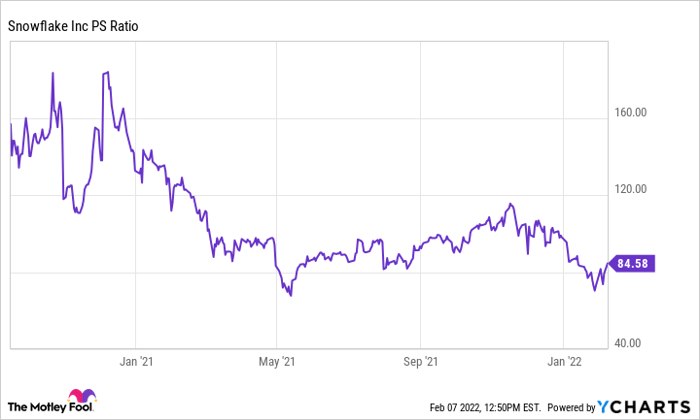Cloud-based data platform Snowflake (NYSE: SNOW) went public in late 2020 amid a ton of hype, including its rapid growth and backing from Warren Buffett, whose Berkshire Hathaway bought $250 million in shares at the IPO price. The stock went to sky-high valuations in its early trading days.
Now, more than a year later, Snowflake continues to execute at a high level, and its shares continue trading at a premium to most stocks on the market. Warren Buffett himself once said that wonderful companies at fair prices are far superior investments to fair companies at wonderful prices.
So where does Snowflake fall on this spectrum, and is it too late for investors to own the stock and still generate strong investment returns? Here's the information that could help answer these questions.

Image Source: Getty Images
What does Snowflake do?
The internet continues to penetrate just about every aspect of our lives, and these days every company is a "tech company' to some degree. Every email, record, transaction, and website click can be recorded, stored, and used to gather insights and make decisions. Now, companies that best use their data have a competitive edge over those that don't.
But it can be a complex undertaking, and many companies are stuck between the "new and old," storing data in an isolated way, like many buckets of different shaped pieces with no way to fit them together.
Snowflake's platform helps fix that, offering companies a unified place to store, manage, and share data. It's cloud-based, so customers don't need to worry about physical equipment, software to install, or upgrades to perform. It's as simple as uploading the data into Snowflake; then, companies can run queries or take advantage of the many integrations Snowflake has with third-party software partners.
Snowflake's fundamentals justify the hype
Snowflake has so much hype, because it's putting up growth metrics among the best of any company on the stock market. The business is growing revenue at a triple-figure rate, up 110% year over year in its most recent report for the fiscal 2022 third quarter.
Multiple levers are driving this growth. First, Snowflake keeps growing its customer base, which now totals 5,416 businesses as of Oct. 31 and increased 52% year over year. There are many thousands of publicly-traded companies and millions of businesses globally, so Snowflake is in the early stages of capturing market share. Out of those customers, 148 spent $1 million or more on Snowflake's platform in the past year, and this cohort of high-value users grew 128%. The company now serves almost half of the Fortune 500.
Customers also spend more with Snowflake once they're on the platform, which is the secret sauce for sustaining long-term growth. The company's dollar-based net revenue retention rate, a measure of existing customers' spending growth, was 173%. In other words, Snowflake's customers are dramatically increasing their spending once they're on board. The company operates a usage-based model, which means that the more data it manages for customers, the more it charges. Data is growing exponentially, which should mean Snowflake's revenue will continue expanding over time.
Its financials are currently crossing a threshold where revenue growth is beginning to outpace expenses. Adjusted free-cash-flow margin was negative 75% in fiscal 2020, negative 12% in fiscal 2021, and positive 6% through the first three quarters of fiscal 2022. Investors should look for the company's cash-flow growth to accelerate in future quarters, putting the business on a path to profitability.
But its valuation reflects the hype too
Snowflake's rapid growth and improving financials have earned a hefty premium on the market. The stock's price-to-sales (P/S) ratio has been among the highest on Wall Street since the stock went public. Though shares trade near their lowest valuation since the IPO, they still command an eye-watering P/S ratio of 85.
Data by YCharts.
Despite generating just over $1 billion of revenue in the past 12 months, the stock carries a market cap of nearly $90 billion. If you were to assume Snowflake sustained 100% annual revenue growth over the next three years, its stock would still trade at 11 times sales at the current share price.
Too late to buy?
How should investors interpret Snowflake's valuation? It seems that, at a minimum, the market has already priced in a lot of the company's near-term potential. Most growth and technology stocks have undergone a substantial sell-off recently, yet Snowflake's premium is here to stay.
Taking a long-term investment approach to the stock can help alleviate the doubt that comes with "paying up" for a quality business. It would give Snowflake time to grow into its valuation over the coming years. However, investors need to realize there's a serious risk that short-term returns will be volatile. At the same time, any hiccup in Snowflake's growth or execution would likely bring about a harsh correction.
Find out why Snowflake Inc. is one of the 10 best stocks to buy now
Our award-winning analyst team has spent more than a decade beating the market. After all, the newsletter they have run for over a decade, Motley Fool Stock Advisor, has tripled the market.*
They just revealed their ten top stock picks for investors to buy right now. Snowflake Inc. is on the list -- but there are nine others you may be overlooking.
Click here to get access to the full list!
*Stock Advisor returns as of January 20, 2022
Justin Pope has no position in any of the stocks mentioned. The Motley Fool owns and recommends Berkshire Hathaway (B shares) and Snowflake Inc. The Motley Fool recommends the following options: long January 2023 $200 calls on Berkshire Hathaway (B shares), short January 2023 $200 puts on Berkshire Hathaway (B shares), and short January 2023 $265 calls on Berkshire Hathaway (B shares). The Motley Fool has a disclosure policy.
The views and opinions expressed herein are the views and opinions of the author and do not necessarily reflect those of Nasdaq, Inc.



